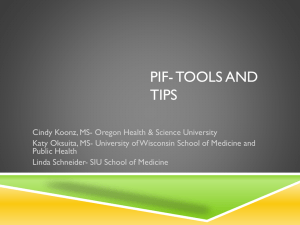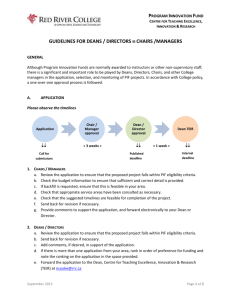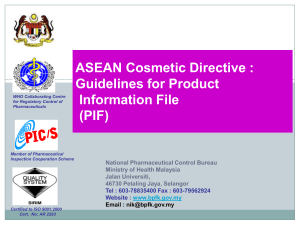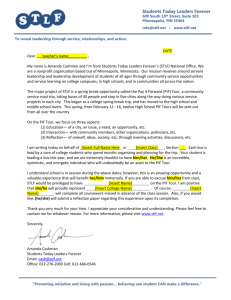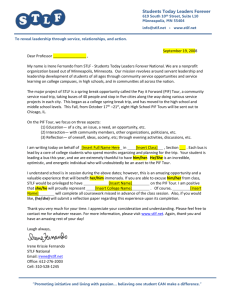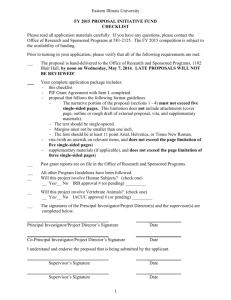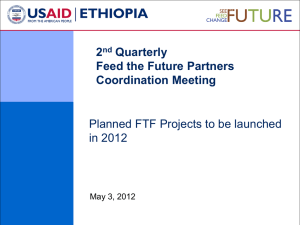Public Improvement Fees as a Development Finance Tool
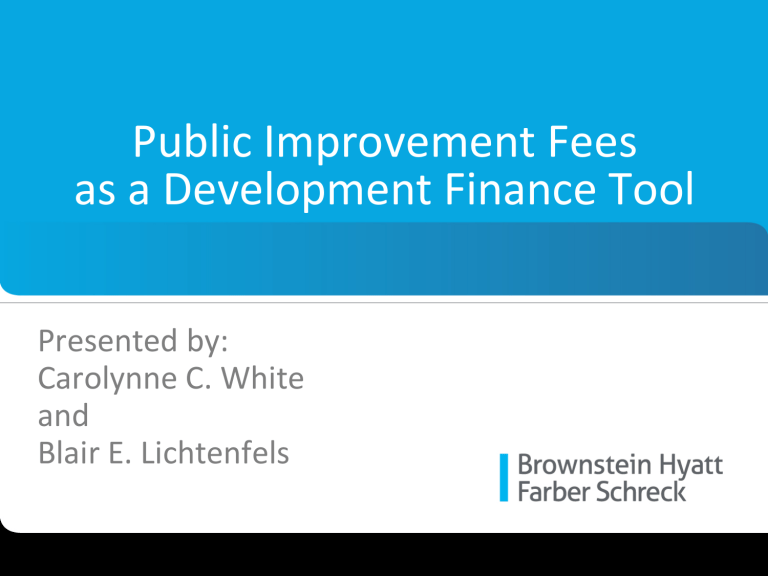
Public Improvement Fees as a Development Finance Tool
Presented by:
Carolynne C. White and
Blair E. Lichtenfels
May 8, 2014
1
Carolynne C. White
•
•
•
Shareholder, Brownstein HyaH Farber Schreck
Co-‐Chair, Real Estate Department
SpecialLes:
•
• land use, zoning and enLtlement process public finance – PIF, TIF, special purpose districts
•
•
•
•
•
•
• public policy state and local government relaLonships redevelopment, infill, mixed use, transit-‐oriented development brownfields urban renewal eminent domain historic preservaLon cwhite@bhfs.com
303.223.1197
2
Blair E. Lichtenfels
•
•
•
•
Associate at Brownstein HyaH Farber Schreck since
2007
Member, Real Estate Department.
Focus on Urban Infill Redevelopment and New
Development, with an emphasis on:
•
•
•
structuring feasibility enLtlements, land use, zoning
•
•
•
•
acquisiLon financing community outreach public-‐private partnerships
Blair has draZed and negoLated mulLple Public
Improvement Fee (PIF) Covenants on behalf of private developers, retail property owners and Title 32 Special
Districts, each of which are one component of complex public financing for various development projects across the State of Colorado. blichtenfels@bhfs.com
303.223.1190
3
1.
2.
3.
4.
5.
6.
7.
8.
9.
Topics for Discussion Today
What is a PIF?
PIF CharacterisLcs
What can PIFs be used for?
PIFs for New Retail Development
PIFs for ExisLng Retail Development
AdministraLon and CollecLon of PIFs
Explaining the PIF to Stakeholders
Public Disclosure
Case Study
4
Public Improvement Fee (“PIF”)
•
A PIF walks like a sales tax, quacks like a sales tax, but it is not a sales tax.
•
Imposed by private contract, not pursuant to governmental taxing power, in the form of:
•
Covenant recorded against the property
•
Retail leases
•
Tenant consent
5
DisLnguishing CharacterisLcs:
PIFs v. Sales Tax
•
PIF
•
•
•
Imposed via private contract or lease
Intended to pay for specific improvements
Those improvements must “touch and concern” and benefit the real property encumbered by the PIF
•
Sales Tax
•
•
•
Imposed by governmental enLty via taxing powers
General revenue raising mechanism
Revenue allocated to governmental authority general fund
6
PIF CharacterisLcs
•
“ Touch and Concern” the land
•
Common law covenant requirement that the PIF touch and concern the land it encumbers
•
Imposed via private covenant recorded against private property or a retail lease
•
OZen, no governmental approval required to impose PIF; no general elecLon
•
Intended to pay for specific improvements that benefit the encumbered property
•
Curbs, sidewalks, street furniture, fountains, landscaping, land purchase, upgraded architecture, pedestrian bridges, structured parking, parks, plazas, open space, water, sewer and storm water faciliLes, roads, street lights, traffic signals, trails and other public ameniLes i.e., public events and markeLng efforts
7
How Can Developers and
Property Owners Use PIFs?
•
Use PIF to pay for installaLon and ongoing maintenance of certain “public” improvements located in retail shopping area
•
Requires analysis of:
•
All costs associated with any type of public improvement on the property, together with
•
All potenLal sources of revenue to finance construcLon of those public improvements.
8
LimitaLons on Sources of Revenue for
Public Improvements
Threshold Inquiry: Does the PIF Touch and Concern the Land and
Benefit the Property?
Statutory Authority
Political Will IRS Regulations
9
Strategic ConsideraLons – New Retail
Development
•
Consider PIF as one component of public finance package for new development.
•
Issuance of tax exempt bonds?
•
Pledge of Tax Increment Financing Revenue from Urban
Renewal Authority?
•
MoneLze PIF revenue via convenLonal loan ?
•
Type of Development? Total tax burden on adjacent and neighboring properLes?
10
Strategic ConsideraLons-‐ New Retail
Development (cont’d)
•
Which retailers are being targeted for inclusion in the development?
•
How will the PIF be administered? Through a Title 32
Metropolitan District or a PIC?
•
Who will enforce and collect the PIF Revenue? A PIC? A
District? The applicable governmental authority?
•
Is the PIF amount to be fixed? Will it be based on a formula?
•
Who has the right to change the PIF amount in the future (if anyone)?
11
Add On PIF v. Credit PIF
•
In addiLon to (and on top of) the City’s current sales tax
(“Add On PIF”)
•
No need to get municipal approval
•
City can reduce its sales tax rate via a credit to lower total impact on buyers (“Credit PIF”)
•
Credit PIF can only be imposed within a municipality (not on property located in an unincorporated county)
•
Requires municipal agreement with City
12
Strategic ConsideraLons – ExisLng Retail
Development
•
A PIF or RSF (Retail Sales Fee) can be imposed upon exisLng retail developments
•
Why?
•
Ideal for exisLng retail developments that would benefit from public ameniLes and public improvements
•
Especially if local municipality is unwilling or unable to fund those improvements/ameniLes
13
ImplementaLon of PIFs within ExisLng
Developments
•
Requires consent of property owner and/or tenant
•
OpLmal to have all property owners/tenants parLcipate in collecLon of PIF in order to eliminate potenLal compeLLve disadvantage
•
Prepare talking points for property owners/retailers re: advantages of PIF structure to pay for public improvements
•
• straight pass-‐through to customers if everyone parLcipates, no compeLLve disadvantage
•
• preferable to tax or fee improve streetscape, façade improvements, etc.
14
ImplementaLon of PIFs within ExisLng
Developments (cont’d)
•
Need to obtain consent of property owners/tenants before implementaLon
•
No need to record a PIF Covenant against the real property
•
Landlord needs to update future leases and lease amendments to include covenant to collect and remit
PIF
15
AdministraLon, CollecLon and Enforcement
•
Retailers are required to collect and report on the PIF
•
Who should collect the PIF from the Retailers?
•
•
•
•
PIC
Governmental EnLty
Title 32 Metro District
Other
•
Enforcement:
•
•
Private Contractual Remedy (whether imposed via PIF Covenant or lease)
A recorded PIF Covenant establishes lien rights against real property, but these lien rights need to be considered in context of other liens and pracLcaliLes of enforcement
16
Explaining the PIF to Different Stakeholders
•
PotenLal Stakeholders:
•
Property Owners
•
Third Party Real Property Purchasers i.e.., parLes taking subject to real property encumbered by PIF
•
Retailers/Tenants
•
Governmental EnLLes
•
UlLmate Consumer
17
Public Disclosure
•
Important to educate the general public about the PIF
•
Amount of the PIF
•
Public benefit from imposiLon of the PIF
•
•
Post placard at register/point of sale – Describe PIF, benefits etc.
Recommend posLng informaLon at the property and on the internet
•
See The Promenade Shops at Centerra InformaLon from www.lovelandpoliLcs.com
•
For retailers and consumers
18
19
20
Project
Belmar
Sample Colorado PIFs
Jurisdiction Local Sales Tax
County
Sale Tax
State
Sales
Tax
Other Taxes Waiver PIF
City of Lakewood /
Jefferson County
2% city tax rate is 3%
.5%
RTD/CD/FD
1.2%
2.5%
2.9% 1%
Colorado Mills
City of Lakewood /
Jefferson County
2% city tax rate is 3%
.5%
Creekside Shopping
Center
Pueblo Crossing Retail
Center
City of Lakewood /
Jefferson County
2% city tax rate is 3%
.5%
City of Pueblo /
Pueblo County
3.5% 1%
Promenade Shops at
Centerra
The Broadmoor
Glenwood Meadows
Prairie Center
Westminster Mall
City of Loveland /
Boulder county
3%
El Paso County 2.5%
.8%
1%
City of Glenwood
Springs / Garfield
County
3.7% 1%
City of Brighton/
Adams County
2.5%
City tax rate is
3.75%
.7%
City of Westminster/
Jefferson County
3.85%
(.25 dedicated to open space; .6 dedicated to public safety)
.5%
2.9%
2.9%
2.9%
2.9%
RTD/CD/FD
1.2%
RTD/CD/FD
1.2% none none none
1.25%
1.4%
7.0%
1.5%
8.1%
.5% capped at
$1.5M
1.25%
Also a Retail
Sales Fee of
1%
7.9%
7.7%
2.9%
2.9%
Pikes Peak RTA
1%
Lodging Tax 2% none
Roaring Fork
RTA
.6% none
2.25%
1.5%
11.65%
9.7%
2.9%
RTD/CD/FD
1.2%
"Credit PIF"
1.25%
"Add On PIF"
1%
8.3%
2.9%
RTD/CD/FD
1.2% none none
Total Tax/
PIF Burden
8.1%
8.45%
21
Case Study
•
Property Owner owns and operates a successful retail shopping center in large metropolitan area. Property Owner owns most of shopping area in fee simple, and leases shops to a variety of tenants (15+).
•
Tenants include retail shops and restaurants.
•
The shopping area is very successful, but Property Owner wants to improve the facades of all buildings, upgrade the exisLng streetscape ameniLes and host public events to promote the shopping area and aHract shoppers.
•
Property Owner has financed property via a convenLonal bank loan secured by a mortgage recorded against the property.
22
Case Study
•
What does the Property Owner need to consider in order to determine whether to use PIF as a financing mechanism?
•
If PIF is an appropriate financing mechanism, what does the
Property Owner need to consider in order to determine the structure of the PIF?
23
Case Study ConsideraLons
•
Can Property Owner obtain consent of all Tenants?
•
CompeLLve Disadvantage in Imposing PIF?
•
How will PIF funds be spent?
•
Any lodging uses at the Property?
•
What types of improvements does Developer intend to finance with
PIF revenues?
•
How will that financing work?
•
Who will collect the PIF from Tenants?
•
How to convince resistant Tenants?
24
QuesLons about PIF?
Call or email Carolynne or Blair: cwhite@bhfs.com
or 303.223.1197 blichtenfels@bhfs.com
or 303.223.1190
25
